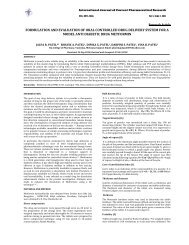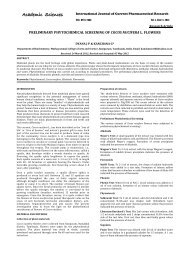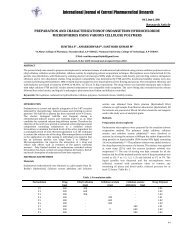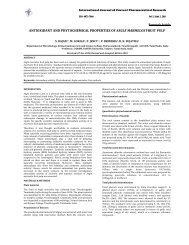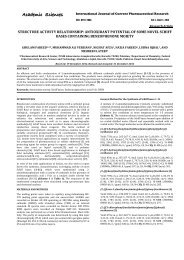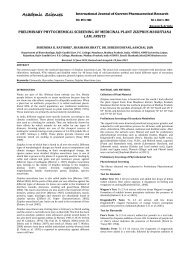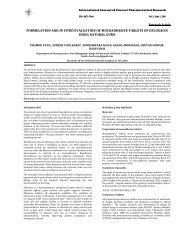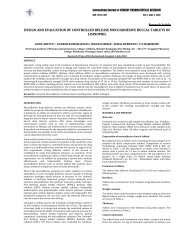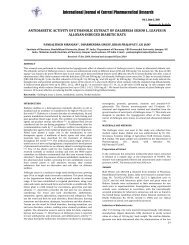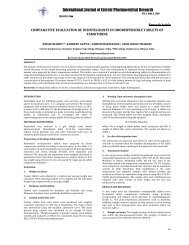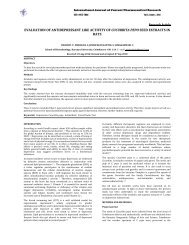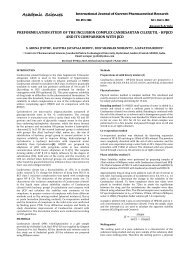solubility enhancement potential of tamarind seed polysaccharide ...
solubility enhancement potential of tamarind seed polysaccharide ...
solubility enhancement potential of tamarind seed polysaccharide ...
- No tags were found...
You also want an ePaper? Increase the reach of your titles
YUMPU automatically turns print PDFs into web optimized ePapers that Google loves.
Academic SciencesInternational Journal <strong>of</strong> Current Pharmaceutical ResearchISSN- 0975-7066 Vol 4, Issue 4, 2012Research ArticleSOLUBILITY ENHANCEMENT POTENTIAL OF TAMARIND SEED POLYSACCHARIDE AS ASOLUBILIZERABSTRACTANAMIKA SATLE*, SHIKHA AGRAWALDepartment <strong>of</strong> Pharmacy, Swami Vivekanand College <strong>of</strong> Pharmacy, Indore (M.P.)Received: 21 August 2012, Revised and Accepted: 08 September 2012Solubility behavior <strong>of</strong> a drug is one <strong>of</strong> the key determinants <strong>of</strong> its oral bioavailability. In recent years, the number <strong>of</strong> poorly soluble drug candidateshas increased tremendously. The formulation <strong>of</strong> poorly soluble drugs for oral delivery presents a challenge to the formulation scientists.The presentstudy has shown that it is possible to increase the dissolution rate <strong>of</strong> poorly soluble drugs like Acecl<strong>of</strong>enac, Atorvastatin, Irbesartan, by preparingsolid dispersion using Tamarind Seed Polysaccharide a water soluble polymer as solubilizer. Physical mixture and Solid Dispersion <strong>of</strong> Acecl<strong>of</strong>enac,Atorvastatin, Irbesartan with Tamarind Seed Polysaccharide (TSP) in ratio <strong>of</strong> 1:1, 1:3, 1:5 were prepared. Solubility study, Drug content andDissolution pr<strong>of</strong>ile study were performed for Acecl<strong>of</strong>enac, Atorvastatin, Irbesartan in Solid dispersions FS1, FS2, FS3, FS5, FS6, FS7, FS8, FS9 as wellas in Physical mixtures FP10, FP11, FP12, FP13, FP14, FP15, FP16, FP17, FP18. It was observed that solid dispersions <strong>of</strong> each drugs showed increasein dissolution rate in comparision with its pure drug in the ratio <strong>of</strong> 1:3 (Drug: TSP). The selected formulations <strong>of</strong> Acecl<strong>of</strong>enac (FS2), Atorvastatin(FS5), Irbesartan (FS8) with TSP were subjected to Accelerated stability study. The prepared Solid Dispersion Formulations <strong>of</strong> Acecl<strong>of</strong>enac,Atorvastatin, Irbesartan using Tamarind Seed Polysaccharide as solubilizer were found to be quite stable. It can be concluded that with the carefuland proper use <strong>of</strong> Tamarind Seed Polysaccharide, <strong>solubility</strong> <strong>of</strong> poorly soluble drugs can be improved.Keywords: Acecl<strong>of</strong>enac, Atorvastatin, Irbesartan, Tamarind Seed Polysaccharide, (TSP), Solubility, DissolutionINTRODUCTIONTherapeutic effectiveness <strong>of</strong> a drug depends upon the bioavailabilityand ultimately upon the <strong>solubility</strong> <strong>of</strong> drug molecules. Solubilitybehavior <strong>of</strong> a drug is one <strong>of</strong> the key determinants <strong>of</strong> its oralbioavailability. In recent years, the number <strong>of</strong> poorly soluble drugcandidates has increased tremendously. The formulation <strong>of</strong> poorlysoluble drugs for oral delivery presents a challenge to theformulation scientists. The rate and extent <strong>of</strong> dissolution <strong>of</strong> theactive ingredient from any dosage form <strong>of</strong>ten determines the rate <strong>of</strong>extent <strong>of</strong> absorption <strong>of</strong> the drug 1 .The development <strong>of</strong> novel dosage form <strong>of</strong> drug delivery systems hasresulted in a need for new excipients to support the desiredproperties. In novel drug delivery systems, polymer plays a vitalrole. Development <strong>of</strong> new excipients is time consuming, involvestedious procedures and is highly expensive. Instead, identification <strong>of</strong>new uses for the existing substances is relatively inexpensive andless time consuming. There has been ever increasing demand for theplant based products as excipients 3 . Natural polymers haveadvantages over synthetic and semi-synthetic polymers like lowcost, natural origin, less side effects, locally available and betterpatient tolerance. However, these natural substances suffer with thedrawbacks like purity, source and microbial contamination. If thesefactors can be identified and controlled, natural substance can begood substitute for synthetic polymers 5 .Tamarind <strong>seed</strong> <strong>polysaccharide</strong> (TSP) is a biodegradable<strong>polysaccharide</strong> extracted from Tamarind <strong>seed</strong>s (Tamarandusindica Linn. Family; Leguminosae) called as TSP has been found tohave a wide application in pharmaceutical industry 5 . Tamarind<strong>seed</strong> <strong>polysaccharide</strong> (TSP) was evaluated for its suitability as acarrier to improve the dilution rate <strong>of</strong> Celecoxib, a drug poorlysoluble in water. Bioavailability <strong>of</strong> certain drugs has beensignificantly improved by the use <strong>of</strong> Tamarind <strong>seed</strong> <strong>polysaccharide</strong>(TSP) 4 .Solid dispersion is one <strong>of</strong> the most promising approaches for<strong>solubility</strong> <strong>enhancement</strong>. More than 60% <strong>of</strong> <strong>potential</strong> drug productssuffer from poor water <strong>solubility</strong>, and due to lipophilic nature posingproblems in their formulation into delivery system. Experience withsolid dispersions over the last 20-30 years indicates that this is avery fruitful approach to improving the release rate and oralbioavailability <strong>of</strong> poorly water soluble drugs 10 .MATERIALS AND METHODSMaterialsDrugs Acecl<strong>of</strong>enac, Atorvastatin and Irbesartan received as giftsample. Tamarind Seeds procured from local market. Potassiumdihydrogen phosphate, Sodium hydroxide, Disodium hydrogenphosphate, Sodium chloride, n-octanol, distilled water, Ethanol,Methanol, and Acetone, Chlor<strong>of</strong>orm, Hydrochloric acid were <strong>of</strong>analytical grade and procured from SDFCL and HIMEDIA.MethodsPreparation <strong>of</strong> Physical MixturePhysical mixture <strong>of</strong> Acecl<strong>of</strong>enac, Atorvastatin, Irbesartan withTamarind Seed Polysaccharide (TSP) in ratio <strong>of</strong> 1:1, 1:3, 1:5 wereprepared by mixing. All the ingredients were weighed accurately in apredetermined ratio and pulverized by light triturating for 5minutes in mortar till a homogenous mixture was obtained. Thismixture was passed through sieve 80 for uniform size and stored indesiccators for further use 6 .Preparation <strong>of</strong> Solid DispersionSolid Dispersion <strong>of</strong> Acecl<strong>of</strong>enac, Atorvastatin, Irbesartan withTamarind Seed Polysaccharide (TSP) in ratio <strong>of</strong> 1:1, 1:3, 1:5 wereprepared by Cogrinding. All the ingredients were weighed accuratelyin a predetermined ratio and pulverized by grinding for 30 minutesin mortar and pestle till a homogenous mixture was obtained. Thismixture was passed through sieve 80 for uniform size and stored indesiccators for further use 12 .Determination <strong>of</strong> Equilibrium Solubility <strong>of</strong> Drugs (Acecl<strong>of</strong>enac,Atorvastatin, Irbesartan ) in formulationsSolubility study was performed according to the method reported byHiguchi and Connors. To evaluate the increase in <strong>solubility</strong> <strong>of</strong>Acecl<strong>of</strong>enac, Atorvastatin, Irbesartan in Solid dispersions FS1, FS2,FS3, FS5, FS6, FS7, FS8, FS9 as well as in Physical mixtures FP1, FP2,FP3, FP4, FP5, FP6, FP7, FP8, FP9. Excess <strong>of</strong> formulations wereadded to 25 ml <strong>of</strong> distilled water taken in a stoppered conical flaskswere shaken for 8 hrs at 37+1 o C 1in incubator shaker. And solutionswere kept for 24 hrs. after shaking to achieve equilibrium, 2 mlaliquots were withdrawn and filtered through whatman filter paper.The filtrate was analysed spectrophotometrically 13 at λmax. 275 nm(Acecl<strong>of</strong>enac), 246.5 nm (Atorvastatin), 244 nm (Irbesartan) against
Satle et al.Int J Curr Pharm Res, Vol 4, Issue 4, 67-73blank. Readings were taken in triplicate and observations arerecorded in table 1, 2, 3.Dissolution Pr<strong>of</strong>ile Study <strong>of</strong> Acecl<strong>of</strong>enac 1 , Atorvastatin 2 ,Irbesartan 3 FormulationsThe dissolution rate testing <strong>of</strong> different Acecl<strong>of</strong>enac, Atorvastatin,Irbesartan capsule formulations was studied using USP XXIIdissolution rate testing apparatus, at a speed <strong>of</strong> 50 rpm and thedissolution fluid (900 ml Phosphate buffer pH 7.4 for Acecl<strong>of</strong>enacand Atorvastatin and 0.1 N HCl for Irbesartan) was maintained at atemperature <strong>of</strong> 37.50± 0.5 0 C. At specific time intervals, a 5 mlaliquot <strong>of</strong> dissolved medium was withdrawn and was replaced withfresh quantity <strong>of</strong> dissolution medium. The samples were suitablydiluted with dissolution medium and assayed for Acecl<strong>of</strong>enaccontent by measuring the absorbance at 275 nm and forAtorvastatin content at 246.5 nm and for Irbesartan content at 244nm using U.V Spectrophotometer. Readings were taken in triplicate.Cumulative percentage <strong>of</strong> the drug dissolved from the formulationswas calculated. Observations and results are reported in tableDrug Content Estimation <strong>of</strong> Acecl<strong>of</strong>enac 1 , Atorvastatin 2 ,Irbesartan 3 FormulationsSolid dispersions equivalent to 10 mg <strong>of</strong> Acecl<strong>of</strong>enac, Atorvastatin,Irbesartan (50 mg) were weighed accurately and dissolved in the 10ml <strong>of</strong> methanol and in 50 ml <strong>of</strong> Ethanol (Irbesartan). The solutionwas filtered, diluted suitably and drug content was analyzed forAcecl<strong>of</strong>enac, Atorvastatin and Irbesartan at λmax. 275 nm, 246.5 nmand 244 nm respectively by UV spectrophotometer. Readings weretaken in triplicate and observations are recorded.FTIR StudyAcecl<strong>of</strong>enac, Atorvastatin, Irbesartan Solid Dispersion werecompressed into a pallet along with KBr (KBr pellet technique) usingShimadzu hydraulic press. The FTIR spectrum <strong>of</strong> samples wererecorded in the wave number region <strong>of</strong> 400-4000 cm -1 on a FTIRspectrophotometer (Shimadzu 8300) and presented in fig.7, 8, 9.Differential Scanning CalorimetryDifferential Scanning Calorimetry analysis was performed with aMettler TA 4000 apparatus equipped with a DSC 25 cell. Weighedsamples (5 – 10 mg, Mettler M3 microbalance) were scanned inpierced aluminium pans under static air at a scan rate <strong>of</strong> 10 0 C min -1over a 30 – 200 0 C temperature range. The instrument is calibratedfor temperature and heat flow using Indium as a standard 14 .X - ray Diffraction StudyThe powder X-ray diffraction spectra <strong>of</strong> prepared solid dispersionswere obtained using RU-H3R, Horizontal Rotaflex rotating anode X-ray generator instrument, Rigaku (Rigaku International Corporation,Tokyo). The sample was spread on a graticule and pressed in such away that sample did not fall on keeping the graticule in verticalposition. The graticule was placed in sample holder and exposed toCuKα_-radiation (40 KV, 50 MA), 2θ= 5 0 to 50 0 at a scanning speed3 0 /min and step size 0.04 0 2θ 14 .Stability studyThe selected formulations <strong>of</strong> Acecl<strong>of</strong>enac (FS2), Atorvastatin (FS5),Irbesartan (FS8) with TSP were subjected to Accelerated stabilitystudy as per ICH guidelines at different temperature conditions suchas room temperature (25 0 C) and at 40±2 0 C/75±5 % RH for a period<strong>of</strong> 3 months.RESULTS AND DISCUSSIONOptimization <strong>of</strong> solid dispersionEquilibrium Solubility Study <strong>of</strong> Acecl<strong>of</strong>enac in Different Formulationsuch as FS1, FS2, FS3, FP1, FP2, FP3 and pure Acecl<strong>of</strong>enac wasperformed. Result indicates that <strong>solubility</strong> <strong>enhancement</strong> percentageis best in case <strong>of</strong> formulation FS2 which is in the ratio <strong>of</strong> 1:3, whencompared with pure drug. Order <strong>of</strong> Solubility <strong>enhancement</strong>,FS2>FS3>FS1> FP2>FP3>FP1>Pure Acecl<strong>of</strong>enac.Table 1: Equilibrium Solubility Study <strong>of</strong> Acecl<strong>of</strong>enac FormulationsS. No. Formulation code Equilibrium <strong>solubility</strong> (μg/ ml at 37+1 0 C in Water) Percentage Solubility Enhancement (%)1 Pure Acecl<strong>of</strong>enac 0.0742. FS1 13.97 188.783. FS2 19.22 259.724. FS3 17.98 240.975. FP1 7.28 98.376. FP2 11.61 156.897. FP3 10.89 143.16Table 2: Equilibrium Solubility Study <strong>of</strong> Atorvastatin FormulationsS. No. Formulation code Equilibrium <strong>solubility</strong> (μg/ ml at 37+1 0 C in Water) Percentage Solubility Enhancement (%)1 Pure Atorvastatin 0.0692. FS4 14.12 204.633. FS5 20.03 290.894. FS6 18.98 275.075. FP4 9.18 133.046. FP5 15.16 219.717. FP6 14.99 210.46Equilibrium Solubility Study <strong>of</strong> Atorvastatin in Different Formulationsuch as FS4, FS5, FS6, FP4, FP5, FP6 and pure Atorvastatin wasperformed. Result indicates that <strong>solubility</strong> <strong>enhancement</strong> percentagewas best in case <strong>of</strong> formulation FS5 which is in the ratio <strong>of</strong> 1:3, whencompared with pure drug. Order <strong>of</strong> Solubility <strong>enhancement</strong>,FS5>FS6>FS4>FP5> FP6>FP4>Pure Atorvastatin.Table 3: Equilibrium Solubility Study <strong>of</strong> Irbesartan FormulationsS. No. Formulation code Equilibrium <strong>solubility</strong> (μg/ ml at 37+1 0 C in Water) Percentage Solubility Enhancement (%)1 Pure Irbesartan 0.0582. FS7 12.65 218.103. FS8 16.12 277.934. FS9 15.48 256.895. FP7 6.91 119.136. FP8 9.12 157.247. FP9 8.88 143.1068
Satle et al.Int J Curr Pharm Res, Vol 4, Issue 4, 67-73Equilibrium Solubility Study <strong>of</strong> Irbesartan in Different Formulationsuch as FS7, FS8, FS9, FP7, FP8, FP9 and pure Irbesartan wasperformed. Result indicates that <strong>solubility</strong> <strong>enhancement</strong> percentagewas best in case <strong>of</strong> formulation FS8 which is in the ratio <strong>of</strong> 1:3, whencompared with pure drug. Order <strong>of</strong> Solubility Enhancement,FS8>FS9>FS7> FP8>FP9>FP7.Fig. 1: Equilibrium Solubility Study <strong>of</strong> Acecl<strong>of</strong>enac in DifferentFormulationFig. 2: Equilibrium Solubility Study <strong>of</strong> Atorvastatin in DifferentFormulationFig. 3: Equilibrium Solubility Study <strong>of</strong> Irbesartan in Different FormulationTable 4: Dissolution pr<strong>of</strong>ile <strong>of</strong> Acecl<strong>of</strong>enac formulationsTime (min) Pure drug FS1 FS2 FS3 FP1 FP2 FP30 0.0 0.0 0.0 0.0 0.0 0.0 0.010 2.65 6.96 9.92 8.09 4.36 5.09 5.1620 5.81 16.86 25.12 21.95 10.36 14.82 12.9330 12.12 29.36 42.23 37.45 18.19 25.93 23.6540 19.45 41.75 55.46 50.65 31.64 38.14 35.8850 25.29 63.96 77.44 73.86 44.52 55.28 50.9960 30.96 80.99 96.87 89.89 51.56 72.86 67.96Solid dispersion <strong>of</strong> Acecl<strong>of</strong>enac showed significant increase in thedissolution rate as compared with pure Acecl<strong>of</strong>enac. The amount <strong>of</strong>pure drug dissolved after one hour was 30.96 %, while for soliddispersion with TSP (1:1) it was 80.99 % and for Solid Dispersionwith TSP (1:3) it was 96.87 % and for Solid Dispersion with TSP(1:5) it was 89.89 %. For Physical Mixture with TSP (1:1) it was51.56 % and for Physical Mixture with TSP (1:3) it was 72.86 % andfor Physical Mixture with TSP (1:5) it was 67.96 %. All the physicalmixtures and solid dispersions showed improved dissolution overpure Acecl<strong>of</strong>enac.Table 5: Dissolution pr<strong>of</strong>ile <strong>of</strong> Atorvastatin formulationsTime (min) Pure drug FS4 FS5 FS6 FP4 FP5 FP60 0.0 0.0 0.0 0.0 0.0 0.0 0.010 3.12 8.36 9.97 9.01 4.97 6.89 6.0520 7.85 18.23 26.36 21.65 10.36 15.22 13.9330 12.96 32.08 40.56 37.45 18.42 25.63 21.9140 19.59 43.39 55.91 50.55 29.34 39.14 34.1850 25.92 60.10 78.15 71.84 44.52 56.45 51.9960 31.09 74.25 98.96 91.58 52.54 71.03 67.46Solid dispersion <strong>of</strong> Atorvastatin showed significant increase in thedissolution rate as compared with pure Atorvastatin. The amount <strong>of</strong>pure drug dissolved after one hour was 31.09 %, while for soliddispersion with TSP (1:1) it was 74.25 % and for Solid Dispersionwith TSP (1:3) it was 98.96 % and for Solid Dispersion with TSP(1:5) it was 91.58 %. For Physical Mixture with TSP (1:1) it was52.54 % and for Physical Mixture with TSP (1:3) it was 71.03 % andfor Physical Mixture with TSP (1:5) it was 67.46 %. All the physicalmixtures and solid dispersions showed improved dissolution overpure Atorvastatin.69
Satle et al.Int J Curr Pharm Res, Vol 4, Issue 4, 67-73Table 6: Dissolution Pr<strong>of</strong>ile <strong>of</strong> Irbesartan formulationsTime (min) Pure drug FS7 FS8 FS9 FP7 FP8 FP90 0.0 0.0 0.0 0.0 0.0 0.0 0.010 2.05 7.16 9.12 8.95 5.09 6.12 5.4820 6.85 16.89 22.36 19.65 11.36 15.82 13.9330 12.76 31.08 41.03 37.45 20.19 26.63 22.5140 19.89 46.33 56.98 50.36 31.64 39.14 35.8850 26.92 63.01 78.15 71.56 42.52 53.12 50.9960 30.12 80.65 97.96 91.58 55.56 74.56 69.96Solid dispersion <strong>of</strong> Irbesartan showed significant increase in thedissolution rate as compared with pure Irbesartan. The amount <strong>of</strong>pure drug dissolved after one hour was 30.12 %, while for soliddispersion with TSP (1:1) it was 80.65 % and for Solid Dispersionwith TSP (1:3) it was 97.96 % and for Solid Dispersion with TSP(1:5) it was 91.58 %. For Physical Mixture with TSP (1:1) it was55.56 % and for Physical Mixture with TSP (1:3) it was 74.56 % andfor Physical Mixture with TSP (1:5) it was 69.96 %. All the physicalmixtures and solid dispersions showed improved dissolution overpure Irbesartan.Fig. 4: Percent Cumulative release <strong>of</strong> Acecl<strong>of</strong>enac from itsformulationsFig. 5: Percent Cumulative release <strong>of</strong> Atorvastatin from itsformulationsFig. 6: Percent Cumulative release <strong>of</strong> Irbesartan from its formulationsSo above study shows that dissolution rate <strong>of</strong> all three poorly soluble drug significantly increases in the ratio <strong>of</strong> 1:3 (Drug:TSP). This might give anidea about the quantity <strong>of</strong> TSP that can be used as solubilizer in pharmaceutical preparations.Characterization <strong>of</strong> Solid DispersionFig. 7: FTIR spectra <strong>of</strong> Formulation FS2 Solid Dispersion <strong>of</strong> ACE70
[Satle et al.Int J Curr Pharm Res, Vol 4, Issue 4, 67-73The FTIR spectra <strong>of</strong> pure Acecl<strong>of</strong>enac and its solid dispersion (FS2)shown in Fig. 9.1. The FTIR spectra <strong>of</strong> pure Acecl<strong>of</strong>enac discussed intable No. 6.11 showed characteristic peaks at 3319- 3267 cm -1 (OHalcoholic group), 2970 cm -1 (Aromatic NH stretching), 2937,1921cm -1 (CH Streching and CH2, 1770-1716 cm -1 (C=O), 1589,1577,1508cm -1 (C=C Ring Streching). It might be the possibility <strong>of</strong>intermolecular hydrogen bonding between adjunct Acecl<strong>of</strong>enacmolecules. The spectrum <strong>of</strong> pure Acecl<strong>of</strong>enac is equivalent to thespectra obtained by the addition <strong>of</strong> TSP. This indicates that nointeraction occurred in solid dispersion <strong>of</strong> drug with TSP. Theresults revealed no considerable changes in the IR peaks <strong>of</strong>Acecl<strong>of</strong>enac, when mixed with TSP.Fig. 8: FTIR spectra <strong>of</strong> Formulation FS5 Solid Dispersion <strong>of</strong> ATRThe FTIR spectra <strong>of</strong> pure Atorvastatin and its solid dispersion(FS5) shown in Fig. 8. The FTIR spectra <strong>of</strong> pure Atorvastatinshowed characteristic peaks at 2955.15 cm -1 (C-H stretching),1313.56 cm 1 (C-N stretching), 3059.15 cm -1 (C-OH stretchingalcoholic group), 1564.97 cm -1 (C=O stretching amidic group),3403.27 cm -1 (N-H stretching), 1656.97 cm -1 (C=C bending),751.62 cm -1 , 696.95 cm -1 (C-F stretching), 1104.39 cm -1 (O-Hbending). It might be the possibility <strong>of</strong> intermolecular hydrogenbonding between adjunct Atorvastatin molecules. The spectrum<strong>of</strong> pure Atorvastatin is equivalent to the spectra obtained by theaddition <strong>of</strong> TSP. This indicates that no interaction occurred insolid dispersion <strong>of</strong> drug with TSP. The results revealed noconsiderable changes in the IR peaks <strong>of</strong> Atorvastatin, whenmixed with TSP.Fig. 9: FTIR spectra <strong>of</strong> Formulation FS8 Solid Dispersion <strong>of</strong> IRBThe FTIR spectra <strong>of</strong> pure Irbesartan and its solid dispersion (FS8)shown in Fig. 9. The FTIR spectra <strong>of</strong> pure Irbesartan showedcharacteristic peaks at 3441 cm -1 (N-H stretch), 3131,3057 cm -1(Aromatic C–H stretch), 2959, 2934, 2870, 2664, 2359 cm -1(Aliphatic C-H stretch) 1732 cm -1 (C = O stretch), 1620 cm -1 and1533 cm -1 (Aromatic C=C Bend and Stretch), 1441 and 1414 cm -1 (C–N amide stretch), 1358 & 1341 cm -1 (C=O ketone) 746 cm -1 (ringvibration due to 1,2-disubstituted benzene), respectively. It might bethe possibility <strong>of</strong> intermolecular hydrogen bonding between adjunctIrbesartan molecules. The spectrum <strong>of</strong> pure Irbesartan is equivalentto the spectra obtained by the addition <strong>of</strong> TSP. This indicates that nointeraction occurred in solid dispersion <strong>of</strong> drug and TSP. The resultsrevealed no considerable changes in the IR peaks <strong>of</strong> Irbesartan,when mixed with TSP.Fig. 10: DSC <strong>of</strong> Formulation FS2 Solid Dispersion <strong>of</strong> ACEFig. 11: DSC <strong>of</strong> Formulation FS5 Solid Dispersion <strong>of</strong> ATR71
Satle et al.Int J Curr Pharm Res, Vol 4, Issue 4, 67-73Fig. 12: DSC <strong>of</strong> Formulation FS8 Solid Dispersion <strong>of</strong> IRBDSC study was performed to study any possible drug polymerinteraction. Fig 10, 11, 12 represents DSC <strong>of</strong> formulations FS2, FS5,FS8 assigned for Acecl<strong>of</strong>enac, Atorvastatin, Irbesartan respectively.Fig. 10 exhibits a sharp endothermic peak at 156 °C whichcorresponds to Acecl<strong>of</strong>enac melting point (150 -156 ºC). TheAcecl<strong>of</strong>enac+TSP that is Formulation FS2 exhibit a sharpendothermic peak at 154ºC. Fig. 11, exhibits a sharp endothermicpeak at 164 °C which corresponds to Atorvastatin melting point(159-165ºC). The Atorvastatin+TSP that is Formulation FS5 exhibita sharp endothermic peak at 160ºC. Fig.12 exhibits a sharpendothermic peak at 180 °C which corresponds to Irbesartanmelting point (160-182 ºC). The Irbesartan + TSP that isFormulation FS8 exhibit a sharp endothermic peak at 178ºC. HenceDSC study showed that there was no any drug polymer interaction.Fig. 13: X-ray Diffraction <strong>of</strong> Formulation FS2 Solid Dispersion <strong>of</strong>ACEFig. 14: X-ray Diffraction <strong>of</strong> Formulation FS5 Solid Dispersion <strong>of</strong>ATRFig. 15: X-ray Diffraction <strong>of</strong> Formulation FS8 Solid Dispersion <strong>of</strong> IRBX-ray diffraction patterns <strong>of</strong> fig. 13, 14, 15 revealed that pure drugswere in crystalline state as it showed sharp distinct peaks notably at2Q diffraction angles <strong>of</strong> 12.98 0 , 17.02 0 , 21.65 0 , 25.13 0 , 26.17 0 , 26.88 0 ,27.56 0 and at 13.53 0 , 25.88 0 , 28.97 0 , 32.21 0 , 33.86 0 and at 4.75 0 ,12.49 0 , 19.45 0 , 23.18 0 for Acecl<strong>of</strong>enac, Atorvastatin, Irbesartanrespectively. The reflections (specific peaks) corresponding to thedrug and TSP were also found in the formulation diffractogram withreduced intensity as compared to drug alone. The reduction inintensity and number <strong>of</strong> typical diffraction peaks in formulationdiffractogram suggests reduction in crystalline nature <strong>of</strong> drug andmay be converted from crystalline to amorphous form.Stability Studies• The selected formulations <strong>of</strong> Acecl<strong>of</strong>enac, Atorvastatin,Irbesartan with TSP were subjected to Accelerated stability study.Physical stability studies at different temperature conditions such asroom temperature (25 0 C) and at 40±2 0 C/75±5 % RH for a period <strong>of</strong>3 months. From the Physical Stability studies, it was observed thatSolid Dispersion formulations FS2, FS5, FS8 show no liquification, nocaking, and no color change for 90 days at room temperature. Theformulations FS2, FS5, FS8 showed no caking for 45 days and 75days at 40±2 0 C/75±5 % RH, but slight caking during 90 days. Thisindicates that formulations are physically stable.• The results <strong>of</strong> chemical stability studies showed that the % DrugContent at the end <strong>of</strong> 90 days were not showed any significant changeduring stability studies that is these limits are within the acceptablerange, shows that formulations are chemically stable. The % DrugContent at 90 days time period in formulation FS2 was 98.58 % at roomtemperature and 98.16 % at 40±2 0 C/75±5 % RH and in formulation FS5it was 98.21 % at room temperature and 97.94 % at 40±2 0 C/75±5 % RHand in formulation FS8 it was 97.96 % at room temperature and 97.16 %at 40±2 0 C/75±5 % RH. This study indicates that formulations are stable.• The results <strong>of</strong> chemical stability shows that the % CumulativeDrug release in all the three formulations that is FS2, FS5, FS8 at theend <strong>of</strong> 90 days were not showed any significant change duringchemical stability studies. The % Cumulative Drug release at 90 daystime period in formulation FS2 was 96.12% at room temperature and96.21 % at 40±2 0 C/75±5 % RH and in formulation FS5 it was 98.66 %at room temperature and 98.86 % at 40±2 0 C/75±5 % RH and informulation FS8 it was 97.16 % at room temperature and 97.94 % at40±2 0 C/75±5 % RH. This study indicates that formulations are stable.72
Satle et al.Int J Curr Pharm Res, Vol 4, Issue 4, 67-73Table 7: Percent Drug Content Data for Chemical Stability <strong>of</strong> Solid DispersionTime (Days)Percent Drug ContentRoom temperature (25 0 C)40±2 0 C/75±5 % RHFS2 FS5 FS8 FS2 FS5 FS80 100.00 100.00 100.00 100.00 100.00 100.0015 - - - 99.08 98.69 98.3130 99.01 98.66 98.21 98.93 98.51 98.1745 - - - 98.74 98.25 97.9260 98.89 98.51 98.14 98.69 98.18 97.7675 - - - 98.44 98.03 97.4890 98.58 98.21 97.96 98.16 97.94 97.16Table 8: In-Vitro Dissolution Data for Chemical Stability <strong>of</strong> Solid DispersionTime (Days)Percent Cumulative Drug ReleaseRoom temperature (25 0 C)40±2 0 C/75±5 % RHFS2 FS5 FS8 FS2 FS5 FS80 96.87 98.96 97.96 96.87 98.96 97.9615 96.81 98.93 97.91 96.86 98.94 97.8930 96.69 98.84 97.88 96.79 98.88 97.9145 96.46 98.91 97.81 96.71 98.91 97.7560 96.74 98.76 97.05 96.82 98.81 97.8275 96.56 98.51 97.34 96.77 98.73 97.8890 96.12 98.66 97.16 96.21 98.86 97.94CONCLUSIONThe prepared Solid Dispersion Formulations <strong>of</strong> Acecl<strong>of</strong>enac,Atorvastatin, Irbesartan using Tamarind Seed Polysaccharide assolubilizer, showed improved <strong>solubility</strong> and dissolution characteristicsas compared with the pure drug and also found quite stable.• The proposed solubilizer Tamarind Seed Polysaccharide is safehence; toxicities/safety related issues will not arise as it isherbal polymer and does not have side effects.• All these features <strong>of</strong> polymer (TSP) suggesting its adaptabilityfor large scale manufacturing that is industrial feasibility.• The proposed polymer is herbal and readily available at lowcost so it will generate revenue for country as well as pr<strong>of</strong>it forcompanies.• The proposed technique would be economical, convenient andsafe. Thus it will open chances for preparing formulations withpoorly soluble drugs with improved <strong>solubility</strong> and dissolutionpr<strong>of</strong>ile.• It can be concluded that with the careful and proper use <strong>of</strong>Tamarind Seed Polysaccharide, <strong>solubility</strong> <strong>of</strong> poorly solubledrugs can be improved. After the results <strong>of</strong> this experimentalwork it would not be surprising that many types <strong>of</strong> soliddispersions containing Tamarind Seed Polysaccharide assolubilizer for poorly soluble drug would enter in the market.ACKNOWLEDGEMENTI would like to express my sincere thanks to Dr. P.K. Dubey(Principal, Swami Vivekanand College Of Pharmacy, Indore), Underwhose kind control, the smooth completion <strong>of</strong> my project workbecame possible, so I would like to convey my heartful gratitude tohim for his encouraging guidance throughout my project work. It ismy proud to have worked under the guidance <strong>of</strong> Dr. (Mrs.) ShikhaAgrawal, (Swami Vivekanand College Of Pharmacy, Indore), whogenerously shared her wisdom and expertise with me & hasprovided me an excellent guidance and general interest. I would alsolike to express my sincere thank to Ranbaxy laboratories Ltd, Dewasand IPCA Laboratories, for the gift samples <strong>of</strong> Irbesartan,Acecl<strong>of</strong>enac and Atorvastatin.REFERENCES1. Arunachalam A., Karthikeyan M, Kishore K., Sethuraman S.,Ashutoshkumar S. “Solid Dispersion : An Overview” CurrentPharma Research; Volume 1, Issue 1, October- December 2010.2. Win Laung Chiou, Sidney Riegelman “PharmaceuticalApplications <strong>of</strong> Solid Dispersion Systems” Journal <strong>of</strong>Pharmaceutical Sciences ; Volume 60 Number 9. September19713. Phani kumar G.K., Gangarao Battu, Kotha N.S., Lova Raju “Isolation and Evaluation <strong>of</strong> Tamarind Seed Polysaccharidebeing used as Polymer in Pharmaceutical Dosage Forms”;Research Journal Of Pharmaceutical, Biological and ChemicalSciences; ISSN: 0975-8585.4. Rao PS, Ghosh TP, Krishna S. “Extraction and purification <strong>of</strong>Tamarind <strong>seed</strong> powder”. J Sci Ind Res. 1946; 4: 705.5. Mounika.S, Narayanan.V , Sarath Chandiran.I, Manasa.V,Sushma.S, Mahita .T, Pavani .D “ Pharmaceutical View <strong>of</strong>Tamarind Gum” ; The Pharma Pr<strong>of</strong>essionals Volume 1 – Issue 2: May - August 20116. M. Santhosh Aruna, A. Kishore Babu, Madhurilatha Thadanki, M.Eswara Gupta “Solid Dispersion – An Approach to enhance theDissolution rate <strong>of</strong> Irbesartan” ; International Journal <strong>of</strong> researchin Pharmacy and Chemistry; IJPRC 2011, 1(4); ISSN: 2231 – 27817. Bobe KR, Subrahmanya C R, Suresh Sarasija, Patil M D, Khade TS” Formulation and Evaluation <strong>of</strong> Solid Dispersion <strong>of</strong>Atorvastatin with various carriers”; International Journal <strong>of</strong>Comprehensive Pharmacy; IJCP 2011,1(02); ISSN0976-8157.8. Aleem M. A., Dehghan M.H., Babu Rajesh “ Solid Dispersion – AnApproach to Enhance the Dissolution Rate <strong>of</strong> Acecl<strong>of</strong>enac byusing 3 2 Factorial Design”; International JournalPharmaceutical Science and Research; IJPSR, 2010; Vol 1(12)203 – 208; ISSN0975-8232.9. Uddin Riaz, Ali Farzana, Bsiwas Subrata Kumar “WaterSolubility Enhancement <strong>of</strong> Atorvastatin By Solid DispersionMethod”; Stamford Journal <strong>of</strong> Pharmaceutical Sciences; S. J.Pharm. Sci. 3(2);43 – 4610. K Patidar, M D Kshirsagar, V Saini , P B Joshi, M Soni “SolidDispersion Technology: A Boon for Poor Water Soluble Drugs”Indian Journal <strong>of</strong> Novel Drug delivery 3(2); Apr-Jun 2011; 83-90.11. Wadke DA, Serajuddin A, Jacobson H,“Preformulation testing”. In:Lieberman HA, Lachman L, Schwartz JB, eds. PharmaceuticalDosage Forms: Tablets. New York , NY : Marcel Dekker; 1989; 1-73.12. Watano S. “Solubility <strong>enhancement</strong> <strong>of</strong> poorly soluble drugs byCogrinding in the Micros” Nara Machinery Co., Ltd., Tokyo/J13. Kumar Ashwini G., Choudhary Ram Kumar, Chaitanya CH.“Enhancement <strong>of</strong> Solubility and Dissolution Rate <strong>of</strong> Irbesartanby Solid Dispersion Technique”Asian Journal <strong>of</strong> Pharmaceuticaland Clinical Research; Vol. 4, Issue 2, 2011 ISSN - 0974-2441.14. Meka Anand Kumar, Pola Santhosh, Reddy Karnaker, PrasannaLakshmi “Development, Evaluation and Characterization <strong>of</strong>surface solid dispersion for <strong>solubility</strong> and dissolution<strong>enhancement</strong> <strong>of</strong> Irbesartan” International Journal <strong>of</strong> DrugDevelopment & Research; January-March 2012 ; Vol. 4; Issue1 ;ISSN 0975-9344.73



